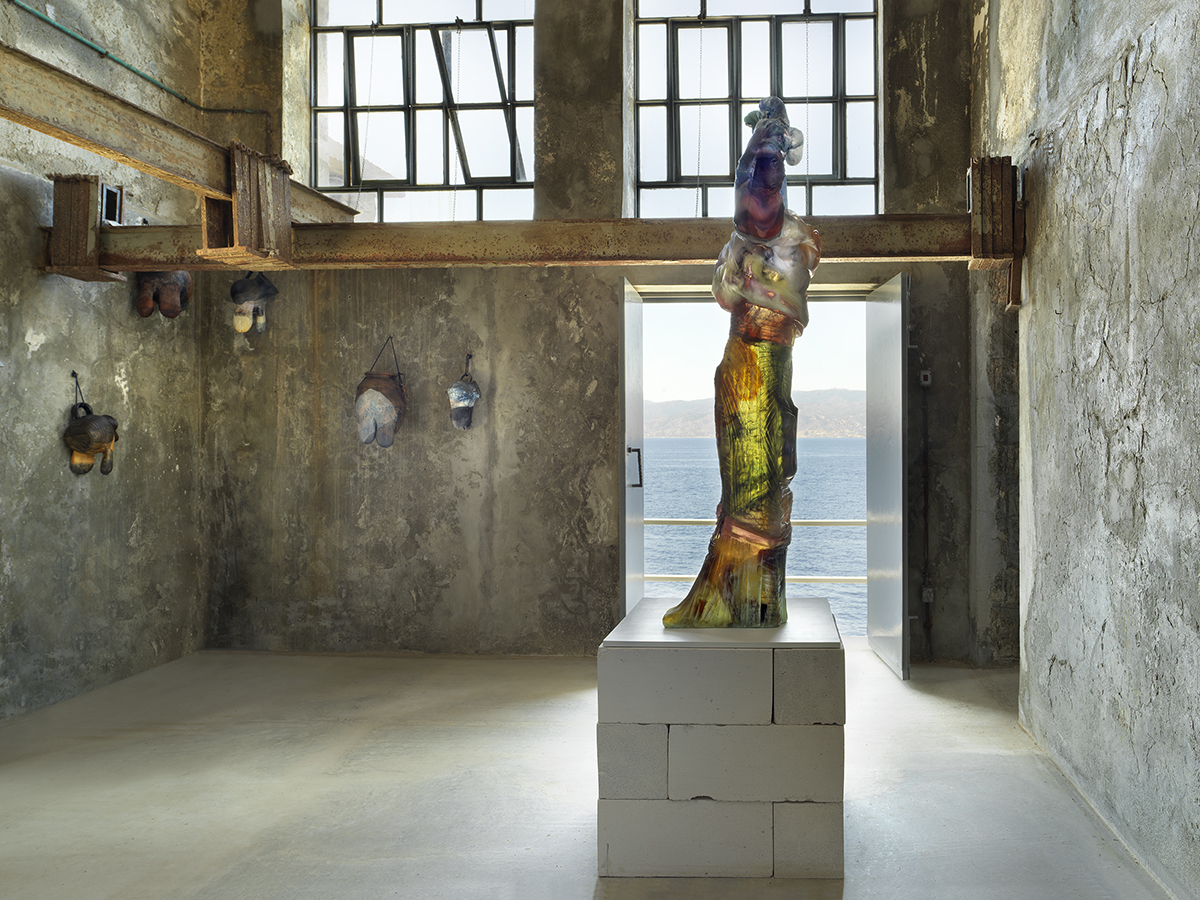

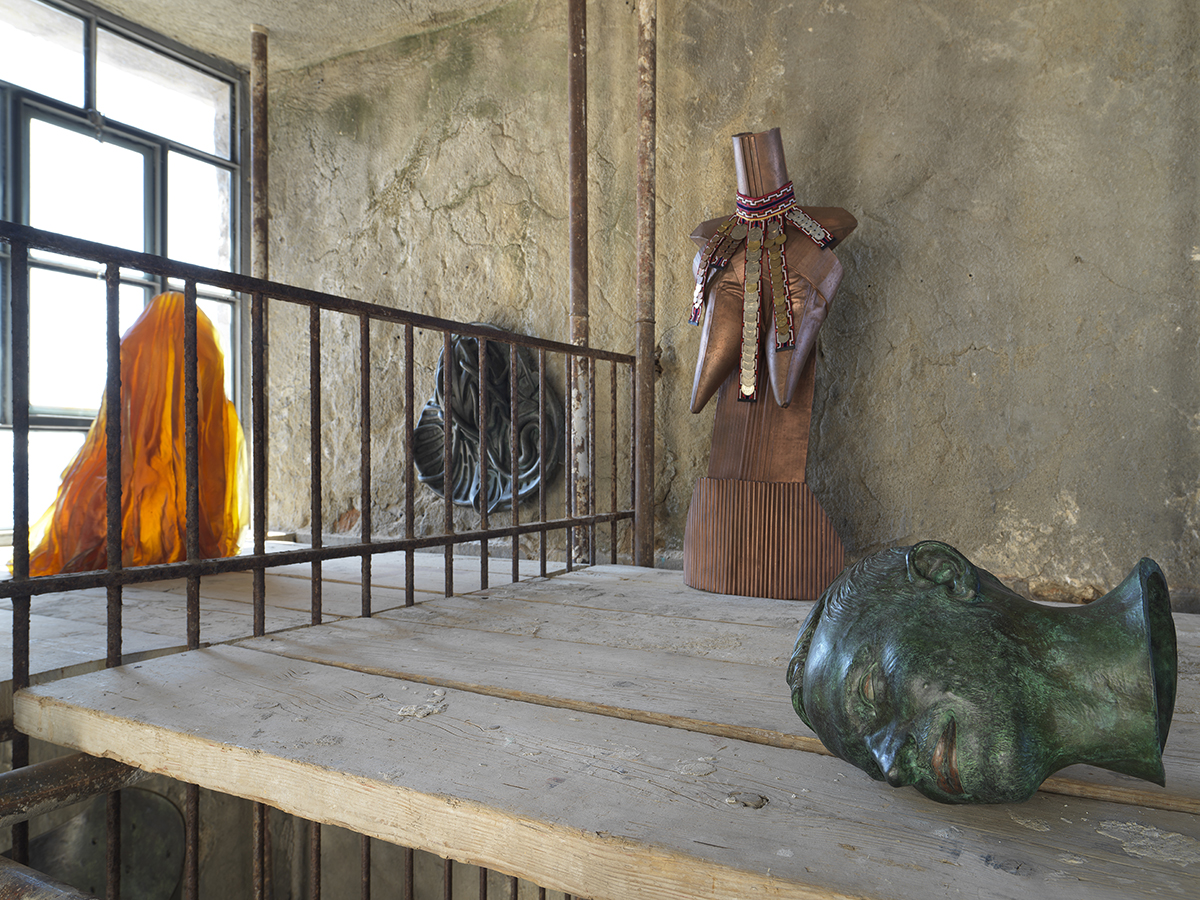

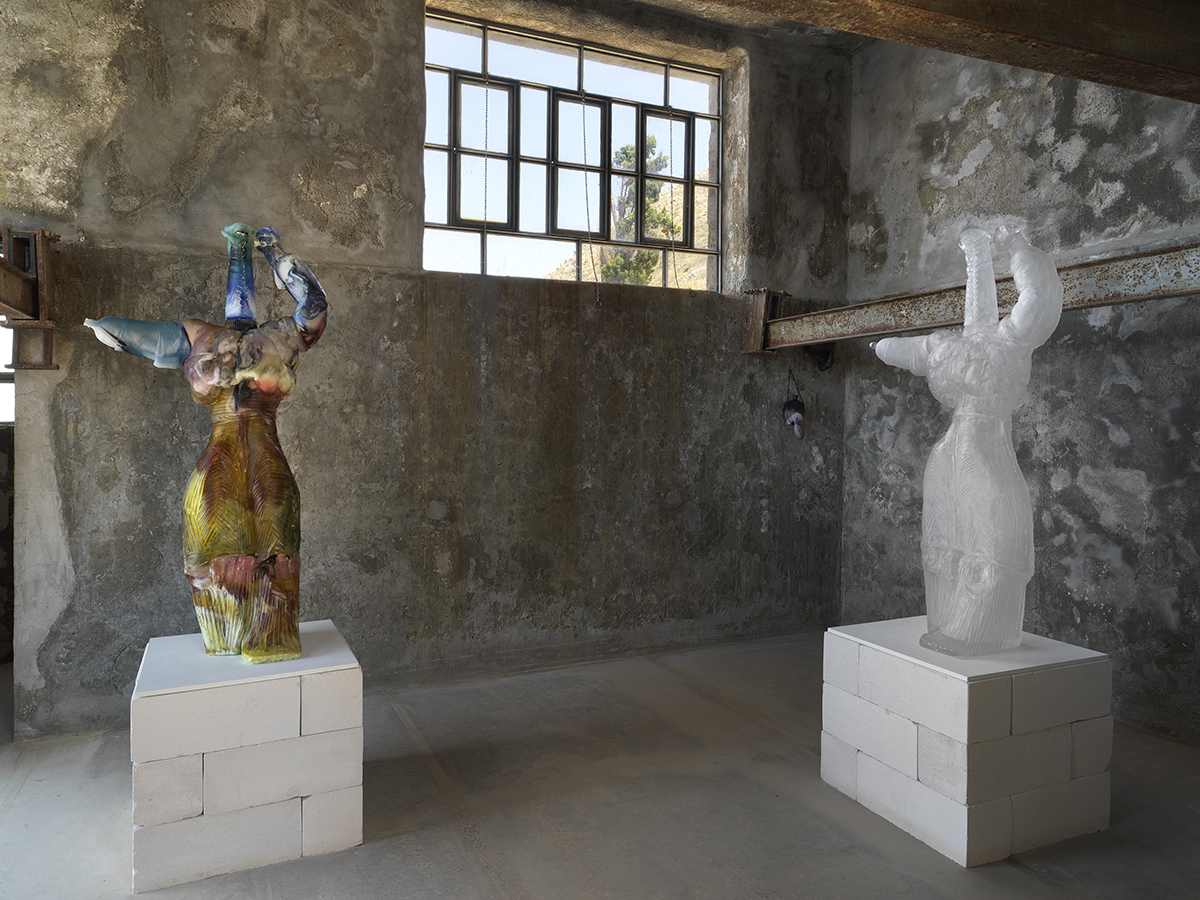
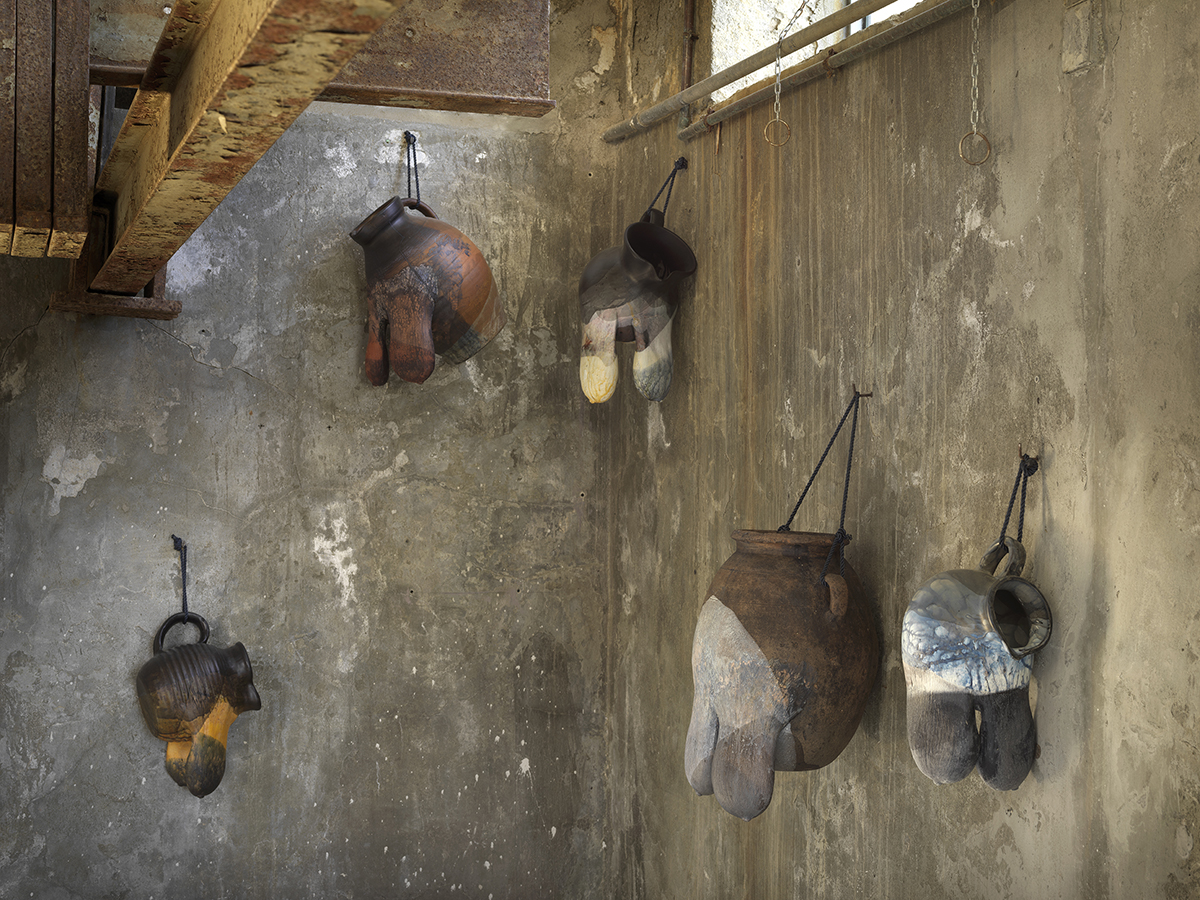
Andra Ursuta
July 2025
Interview run by Timothée Chaillou
Romanian-born, London–based artist Andra Ursuţa builds sculptural worlds out of trash, myth, and melancholy. Known for her visceral approach to materials and darkly humorous narratives, she explores failure, memory, and the body in states of collapse. For her summer show at the Deste Foundation’s Slaughterhouse on Hydra, she transforms the former abattoir into a site of archaeological fiction. Bronze, glass, and discarded studio objects come together in tragicomic assemblages that blur the line between relic and ruin.
Timothée Chaillou
The exhibition venue of the Deste Foundation on Hydra is a former slaughterhouse. This particular site comes with a strong presence. Was that something you wanted to respond to?
Andra Ursuţa
I really don’t like white cubes—the idea of the white hyperspace, neutral and detached. Site-specificity is much more interesting to me. It’s not something you can re-stage endlessly. That’s why I was excited to do a show in this particular place. Also, I grew up in Romania, in a town mostly known for its slaughterhouse!
Bronze is not a material I had really used before. But this time, it felt right. While making the bronzes for the show, I’d been reading a lot about ancient sculpture and casting techniques. What really spoke to me was the idea that many of those sculptures were assemblages—not singular masterpieces, but built from different parts, even reused molds. If a sculpture was popular, they would just remake it again and again, sometimes even during the sculptor’s lifetime. I loved discovering that an ancient sculptor’s studio would be full of molds—arms, legs, eye sockets—ready to be recombined. I had never thought of Greek bronzes as modular or iterative, but that’s what they were.
Timothée Chaillou
Your new sculptures echo that fragmentation. When you look closely at them, you can spot a bike helmet or horseshoe dividers assembled with other elements.
Andra Ursuţa
We all build narratives, and my sculptures are like that. I’m not a hoarder in real life, but in my studio, I am. I often keep bits of trash for years, thinking: maybe one day this will become a sculpture. I lived in New York for over 25 years. Two years ago, I decided it was time to leave. These sculptures carry some of that weight—the archaeology of everyday life. Rather than just throwing things out of the studio, I thought it would be an interesting exercise to qualify this period of time I spent in New York—by creating a kind of archaeological site of whatever happened. For this show, I only used things that were already in my studio.
One of the most overwhelming things in daily life is just the sheer amount of stuff we live with—and all the trash we generate. I find that really oppressive, so I end up making art from trash. Because I don’t know what else to do with it. For example, some of these pieces—like the chair—are also inspired by decorative objects rather than high art. I was looking a lot at Bernard Palissy’s Renaissance plates, with all the dead creatures he depicted. I always found that amazing. The snake platter is a direct reference to that. The droogs are based on a urinal—so it’s a common object, not a highly stylized form. And the chair is a functional object—you can actually sit on it. Some parts, like the legs, come from another sculpture that I recycled. The receptacle at the center of that piece is just a cup I used for mixing resin for years. The armchair has a backrest made from a medical brace I once used. I used the front part for another glass sculpture and didn’t want to waste the back.
Timothée Chaillou
What about the scaffolding system the works are shown on? It evokes museum storage. Was that inspired by actual archaeological displays?
Andra Ursuţa
Yes—specifically the ones at Pompeii, where archaeologists don’t have enough space, so the objects are stored on stacked shelves or inside crates. But the first time I saw something like that was actually around the Acropolis. There were these beautiful carved stones—ancient fragments—just locked in a cage. I found that image so striking. Another inspiration was the Acropolis Museum itself. Not because of what it shows, but because of what it doesn’t show—namely the Parthenon Marbles, which are still in the British Museum. I was thinking a lot about that kind of absence, and what it means to place—or displace—objects.
Timothée Chaillou
What are the glass sculptures exhibited in the central space of the slaughterhouse?
Andra Ursuţa
They’re all bottles. You could technically use them to pour alcohol—if you wanted to. I liked the idea of undercutting the monumentality of the material with something banal and degenerate. We’re in Jeff Koons territory here, after all—luxury and trash, serious and ridiculous, high and low, all mingling together.
Timothée Chaillou
What was your process for making these pieces?
Andra Ursuţa
They’re also based on assemblages—of found objects, things I’ve made by hand, whatever I have around. At some point, the assemblage gets 3D-scanned. Then someone else digitally sculpts it under my direction. The scan is sliced into sections, which are then 3D-printed. Each section becomes a mold. After that, the process is very traditional—it’s similar to lost-wax casting, but with glass. You have a wax form, and you pour molten glass into a refractory mold.
So there’s this interesting cycle: you start with something very analog and handmade, then it gets digitized—almost flattened—and then you return to an analog process through casting. It’s a kind of erasure and reinstatement of both techniques. What you’re left with is an object that bears all these contradictory traces. It’s not always clear where it resides—in relation to real objects, real life, or even real art.
Timothée Chaillou
Titled Half-Drunken Mummy, were they ever actually filled with alcohol?
Andra Ursuţa
No. But some of them have alcohol stains, which I felt was enough. I’ve been working on this body of work since around 2018. The very first iteration was shown in Venice in 2019, and at that time, all the sculptures contained a bit of alcohol inside them. This group of works emerged from me entering my forties and, for the first time, starting to feel like maybe the glass isn't half full—it’s half empty. It was a kind of emotional threshold: I realized I would never be an astronaut, and I had to mourn that.
When you’re younger, you live with this idea that anything is possible—and it’s true. But once you’ve made certain choices, other paths just disappear. As you age, those decisions narrow your life in certain ways. The bottles came out of that feeling. I wanted to create characters that embody a tragic idea—but in a silly way. That’s why one of them is a mummy who seems to be committing suicide. She’s half-drunk, she’s half-empty.
All the figures in this series are engaged in similarly self-destructive acts. They might resemble attempts at wellness or self-improvement—but in the end, they’re about the impossibility of those ideals. They functioned both as serious sculptures and as silly decorative objects—or even utilitarian things. They were tragicomic figures, each involved in some form of self-harm—or at least self-inflicted absurdity.
There was a physicality to them, almost like they were exercising—doing all these awkward movements. But of course, their bodies were falling apart—drooping, sagging. My work is a meditation on failure.
What you see now—both forms—are essentially the same sculpture, done twice. The colorful version is the most recent; it was only completed a few months ago. After finishing the transparent one, I began experimenting with color. To reach these complex color combinations, we first had to succeed in making the clear version.
Timothée Chaillou
Do you think of them as positive and negative forms of each other?
Andra Ursuţa
Not exactly. There’s definitely a relationship between the two, and that’s why I wanted to show them together. It wasn’t just about repeating the form—it was more specifically about the contrast between a colorless figure and its colored counterpart.
This came from a more recent strand of art historical scholarship, which reveals that the classical statues we were taught to see as white were, in fact, very colorful. I became fascinated by the generative potential of a mistake—or a misunderstanding. I think it was Winckelmann, the 18th-century German art historian, who helped establish the ideal of the white, pure classical statue.
And for centuries, that misreading shaped both scholarship and visual culture. People would say things like, “She has no eyebrows”—but in fact, the original sculptures did, and they were painted. It wasn’t some noble Greek ideal of white purity—it was the result of time, erosion, and restoration practices.
But we’ve internalized the white statue as beautiful. I’ve seen exhibitions where you’re shown both: the bleached, worn marble statue and a modern reconstruction of what it originally looked like, fully colored. And I found those reconstructions so hard to accept. They looked awful to me.
And that made me think a lot—about how conditioned we are, how hard it is to unsee something, even when you know it’s wrong. Because seeing is not neutral.
It made me reflect on all the great work that was made—in Neoclassicism, for example—in the name of this erroneous idea of what antiquity looked like. Those works still hold value, of course. But it’s interesting to consider how a mistake can shape entire aesthetics. And how, as a viewer, your brain resists holding both images at once. You can switch between them—but you can’t see both simultaneously.
I was curious whether something similar might happen with a contemporary sculpture. Would people perceive the transparent one as the “high classical” version—clean, noble—and the colorful one as somehow more garish or excessive?
Timothée Chaillou
That reminds me of Jeff Koons and his interpretation of classical statuary—especially his Apollo at the Slaughterhouse in 2022 and the Gazing Ball series.
Andra Ursuţa
Yes! I’m glad you caught that. There are two round, spherical elements in one of the cages outside the main room in the show. They’re a kind of jokey reference to Koons’s Gazing Balls—except of course, you can’t see anything in them. They’re ugly, dirty, opaque. It was a little joke, and I’m glad it landed.
Timothée Chaillou
You once recalled that you were born at a time when abortion was illegal. And I wondered—do you see these sculptures as fetal in form, like an ode to life?
Andra Ursuţa
I hadn’t thought of them that way. My work is definitely body-based—there are a lot of appendages and anatomical references. But I think of these figures as being past their prime, not unborn. If they’re organs, they’re failing organs—not developing ones.
Everything I do is also a bit of a joke. Always. There’s humor in the work, no matter how horrible or grotesque it might seem. A lot of the forms have things growing on them—mutations, swellings, sagging parts—because in a way, that’s a kind of shorthand for failure.
They’re part of the same series as The Half-Drunk Mummy, for example. There’s another piece in that group called Yoga Don’t Help. It’s this absurd yoga pose—but the torso is leaking, the organs are spilling out. It’s about the idea that no matter how hard you try to hold it all together, eventually things give way. It all collapses.
In this show, there’s a similar thread. Like in the Atrophy Room, which is in the main gallery. There’s a group of works I call The Droogs. You can barely see them at first—they kind of disappear into the walls. They’re camouflaged. But if you look closely, they have these sagging, old-woman breasts. Like, old and dried out.
It’s a play on the idea of a trophy room—where you display your conquests. But here, instead of trophies, you get these deflated, drooping reminders of age. So it’s not about triumph—it’s about atrophy. That’s the joke. There’s always something in the object that signals failure.
Timothée Chaillou
Do you draw your sculptures before making them?
Andra Ursuţa
Sometimes. It depends on the piece. I do make sketches occasionally—but more often, I just build directly. I work with my hands and create assemblages, which are then transformed into sculptures.
Timothée Chaillou
Do you think art is useful?
Andra Ursuţa
I don’t think it’s the job of art to address social issues or fix problems in society. I think the job of art is to create a space where you can actually think all the horrible, uncomfortable thoughts. To be responsible and indulgent at the same time.
And yes, there is a utility in that—but not the kind that solves causes. You can’t make art for a cause and then expect the world to fix itself. That’s an unfair expectation to place on art.
Honestly, I find it kind of problematic that nowadays everyone is a creator. Everyone produces “content.” And to me, content is the bane of substance. You don’t want content. You want substance.
I work very hard not to just make more stuff for people to post images of. I want to find integrity in the things I make. That’s also one reason I use a lot of trash in my work.
For instance, there was a time when I used a lot of Halloween decorations. I found them fascinating—not just because they’re a way of talking about death and our collective fear of it—but also because I started thinking about the people who actually make these things, in factories.
They pour their time into producing something that’s meant to be thrown away almost immediately. I find that really sad—that we exchange our time for things we know will be obsolete within days.
Ideally, I’d like to live in a world where, like in ancient cultures, people made things for the afterlife. That’s where they poured their energy—and that gave meaning to their lives.
I know this may sound sentimental or pretentious, but maybe when I transform these objects into artworks, I’m somehow preserving the labor that originally went into them—even if they started out as cheap, throwaway decorations.
Timothée Chaillou
The exhibition venue of the Deste Foundation on Hydra is a former slaughterhouse. This particular site comes with a strong presence. Was that something you wanted to respond to?
Andra Ursuţa
I really don’t like white cubes—the idea of the white hyperspace, neutral and detached. Site-specificity is much more interesting to me. It’s not something you can re-stage endlessly. That’s why I was excited to do a show in this particular place. Also, I grew up in Romania, in a town mostly known for its slaughterhouse!
Bronze is not a material I had really used before. But this time, it felt right. While making the bronzes for the show, I’d been reading a lot about ancient sculpture and casting techniques. What really spoke to me was the idea that many of those sculptures were assemblages—not singular masterpieces, but built from different parts, even reused molds. If a sculpture was popular, they would just remake it again and again, sometimes even during the sculptor’s lifetime. I loved discovering that an ancient sculptor’s studio would be full of molds—arms, legs, eye sockets—ready to be recombined. I had never thought of Greek bronzes as modular or iterative, but that’s what they were.
Timothée Chaillou
Your new sculptures echo that fragmentation. When you look closely at them, you can spot a bike helmet or horseshoe dividers assembled with other elements.
Andra Ursuţa
We all build narratives, and my sculptures are like that. I’m not a hoarder in real life, but in my studio, I am. I often keep bits of trash for years, thinking: maybe one day this will become a sculpture. I lived in New York for over 25 years. Two years ago, I decided it was time to leave. These sculptures carry some of that weight—the archaeology of everyday life. Rather than just throwing things out of the studio, I thought it would be an interesting exercise to qualify this period of time I spent in New York—by creating a kind of archaeological site of whatever happened. For this show, I only used things that were already in my studio.
One of the most overwhelming things in daily life is just the sheer amount of stuff we live with—and all the trash we generate. I find that really oppressive, so I end up making art from trash. Because I don’t know what else to do with it. For example, some of these pieces—like the chair—are also inspired by decorative objects rather than high art. I was looking a lot at Bernard Palissy’s Renaissance plates, with all the dead creatures he depicted. I always found that amazing. The snake platter is a direct reference to that. The droogs are based on a urinal—so it’s a common object, not a highly stylized form. And the chair is a functional object—you can actually sit on it. Some parts, like the legs, come from another sculpture that I recycled. The receptacle at the center of that piece is just a cup I used for mixing resin for years. The armchair has a backrest made from a medical brace I once used. I used the front part for another glass sculpture and didn’t want to waste the back.
Timothée Chaillou
What about the scaffolding system the works are shown on? It evokes museum storage. Was that inspired by actual archaeological displays?
Andra Ursuţa
Yes—specifically the ones at Pompeii, where archaeologists don’t have enough space, so the objects are stored on stacked shelves or inside crates. But the first time I saw something like that was actually around the Acropolis. There were these beautiful carved stones—ancient fragments—just locked in a cage. I found that image so striking. Another inspiration was the Acropolis Museum itself. Not because of what it shows, but because of what it doesn’t show—namely the Parthenon Marbles, which are still in the British Museum. I was thinking a lot about that kind of absence, and what it means to place—or displace—objects.
Timothée Chaillou
What are the glass sculptures exhibited in the central space of the slaughterhouse?
Andra Ursuţa
They’re all bottles. You could technically use them to pour alcohol—if you wanted to. I liked the idea of undercutting the monumentality of the material with something banal and degenerate. We’re in Jeff Koons territory here, after all—luxury and trash, serious and ridiculous, high and low, all mingling together.
Timothée Chaillou
What was your process for making these pieces?
Andra Ursuţa
They’re also based on assemblages—of found objects, things I’ve made by hand, whatever I have around. At some point, the assemblage gets 3D-scanned. Then someone else digitally sculpts it under my direction. The scan is sliced into sections, which are then 3D-printed. Each section becomes a mold. After that, the process is very traditional—it’s similar to lost-wax casting, but with glass. You have a wax form, and you pour molten glass into a refractory mold.
So there’s this interesting cycle: you start with something very analog and handmade, then it gets digitized—almost flattened—and then you return to an analog process through casting. It’s a kind of erasure and reinstatement of both techniques. What you’re left with is an object that bears all these contradictory traces. It’s not always clear where it resides—in relation to real objects, real life, or even real art.
Timothée Chaillou
Titled Half-Drunken Mummy, were they ever actually filled with alcohol?
Andra Ursuţa
No. But some of them have alcohol stains, which I felt was enough. I’ve been working on this body of work since around 2018. The very first iteration was shown in Venice in 2019, and at that time, all the sculptures contained a bit of alcohol inside them. This group of works emerged from me entering my forties and, for the first time, starting to feel like maybe the glass isn't half full—it’s half empty. It was a kind of emotional threshold: I realized I would never be an astronaut, and I had to mourn that.
When you’re younger, you live with this idea that anything is possible—and it’s true. But once you’ve made certain choices, other paths just disappear. As you age, those decisions narrow your life in certain ways. The bottles came out of that feeling. I wanted to create characters that embody a tragic idea—but in a silly way. That’s why one of them is a mummy who seems to be committing suicide. She’s half-drunk, she’s half-empty.
All the figures in this series are engaged in similarly self-destructive acts. They might resemble attempts at wellness or self-improvement—but in the end, they’re about the impossibility of those ideals. They functioned both as serious sculptures and as silly decorative objects—or even utilitarian things. They were tragicomic figures, each involved in some form of self-harm—or at least self-inflicted absurdity.
There was a physicality to them, almost like they were exercising—doing all these awkward movements. But of course, their bodies were falling apart—drooping, sagging. My work is a meditation on failure.
What you see now—both forms—are essentially the same sculpture, done twice. The colorful version is the most recent; it was only completed a few months ago. After finishing the transparent one, I began experimenting with color. To reach these complex color combinations, we first had to succeed in making the clear version.
Timothée Chaillou
Do you think of them as positive and negative forms of each other?
Andra Ursuţa
Not exactly. There’s definitely a relationship between the two, and that’s why I wanted to show them together. It wasn’t just about repeating the form—it was more specifically about the contrast between a colorless figure and its colored counterpart.
This came from a more recent strand of art historical scholarship, which reveals that the classical statues we were taught to see as white were, in fact, very colorful. I became fascinated by the generative potential of a mistake—or a misunderstanding. I think it was Winckelmann, the 18th-century German art historian, who helped establish the ideal of the white, pure classical statue.
And for centuries, that misreading shaped both scholarship and visual culture. People would say things like, “She has no eyebrows”—but in fact, the original sculptures did, and they were painted. It wasn’t some noble Greek ideal of white purity—it was the result of time, erosion, and restoration practices.
But we’ve internalized the white statue as beautiful. I’ve seen exhibitions where you’re shown both: the bleached, worn marble statue and a modern reconstruction of what it originally looked like, fully colored. And I found those reconstructions so hard to accept. They looked awful to me.
And that made me think a lot—about how conditioned we are, how hard it is to unsee something, even when you know it’s wrong. Because seeing is not neutral.
It made me reflect on all the great work that was made—in Neoclassicism, for example—in the name of this erroneous idea of what antiquity looked like. Those works still hold value, of course. But it’s interesting to consider how a mistake can shape entire aesthetics. And how, as a viewer, your brain resists holding both images at once. You can switch between them—but you can’t see both simultaneously.
I was curious whether something similar might happen with a contemporary sculpture. Would people perceive the transparent one as the “high classical” version—clean, noble—and the colorful one as somehow more garish or excessive?

Timothée Chaillou
That reminds me of Jeff Koons and his interpretation of classical statuary—especially his Apollo at the Slaughterhouse in 2022 and the Gazing Ball series.
Andra Ursuţa
Yes! I’m glad you caught that. There are two round, spherical elements in one of the cages outside the main room in the show. They’re a kind of jokey reference to Koons’s Gazing Balls—except of course, you can’t see anything in them. They’re ugly, dirty, opaque. It was a little joke, and I’m glad it landed.
Timothée Chaillou
You once recalled that you were born at a time when abortion was illegal. And I wondered—do you see these sculptures as fetal in form, like an ode to life?
Andra Ursuţa
I hadn’t thought of them that way. My work is definitely body-based—there are a lot of appendages and anatomical references. But I think of these figures as being past their prime, not unborn. If they’re organs, they’re failing organs—not developing ones.
Everything I do is also a bit of a joke. Always. There’s humor in the work, no matter how horrible or grotesque it might seem. A lot of the forms have things growing on them—mutations, swellings, sagging parts—because in a way, that’s a kind of shorthand for failure.
They’re part of the same series as The Half-Drunk Mummy, for example. There’s another piece in that group called Yoga Don’t Help. It’s this absurd yoga pose—but the torso is leaking, the organs are spilling out. It’s about the idea that no matter how hard you try to hold it all together, eventually things give way. It all collapses.
In this show, there’s a similar thread. Like in the Atrophy Room, which is in the main gallery. There’s a group of works I call The Droogs. You can barely see them at first—they kind of disappear into the walls. They’re camouflaged. But if you look closely, they have these sagging, old-woman breasts. Like, old and dried out.
It’s a play on the idea of a trophy room—where you display your conquests. But here, instead of trophies, you get these deflated, drooping reminders of age. So it’s not about triumph—it’s about atrophy. That’s the joke. There’s always something in the object that signals failure.
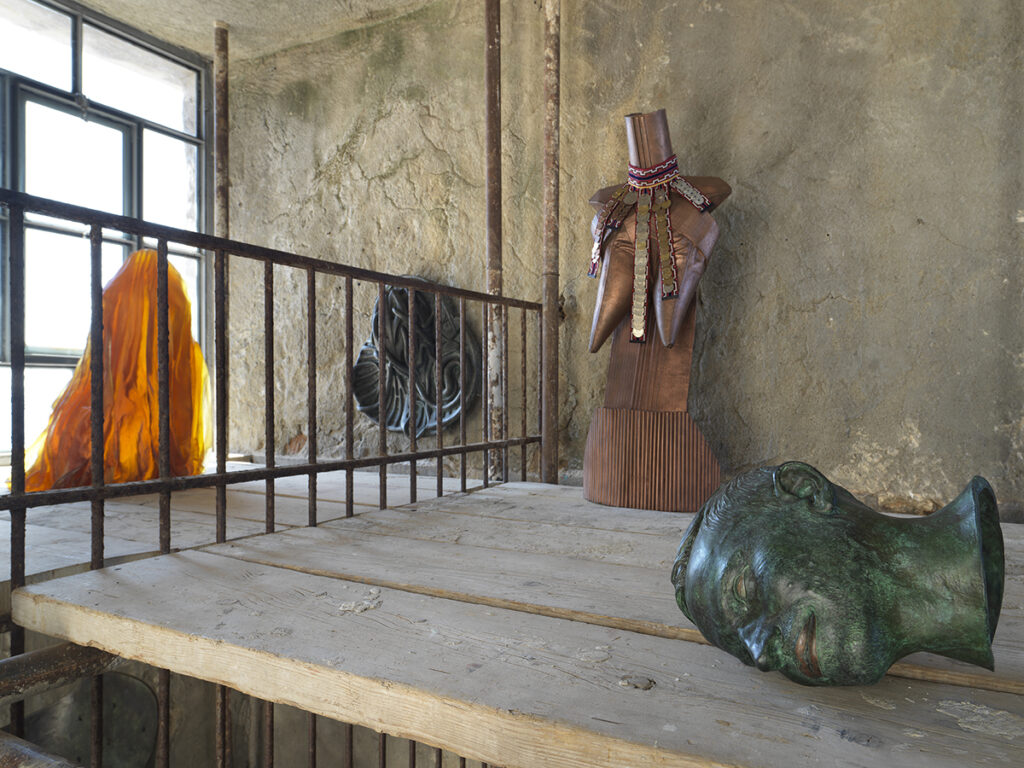
Timothée Chaillou
Do you draw your sculptures before making them?
Andra Ursuţa
Sometimes. It depends on the piece. I do make sketches occasionally—but more often, I just build directly. I work with my hands and create assemblages, which are then transformed into sculptures.
Timothée Chaillou
Do you think art is useful?
Andra Ursuţa
I don’t think it’s the job of art to address social issues or fix problems in society. I think the job of art is to create a space where you can actually think all the horrible, uncomfortable thoughts. To be responsible and indulgent at the same time.
And yes, there is a utility in that—but not the kind that solves causes. You can’t make art for a cause and then expect the world to fix itself. That’s an unfair expectation to place on art.
Honestly, I find it kind of problematic that nowadays everyone is a creator. Everyone produces “content.” And to me, content is the bane of substance. You don’t want content. You want substance.
I work very hard not to just make more stuff for people to post images of. I want to find integrity in the things I make. That’s also one reason I use a lot of trash in my work.
For instance, there was a time when I used a lot of Halloween decorations. I found them fascinating—not just because they’re a way of talking about death and our collective fear of it—but also because I started thinking about the people who actually make these things, in factories.
They pour their time into producing something that’s meant to be thrown away almost immediately. I find that really sad—that we exchange our time for things we know will be obsolete within days.
Ideally, I’d like to live in a world where, like in ancient cultures, people made things for the afterlife. That’s where they poured their energy—and that gave meaning to their lives.
I know this may sound sentimental or pretentious, but maybe when I transform these objects into artworks, I’m somehow preserving the labor that originally went into them—even if they started out as cheap, throwaway decorations.




